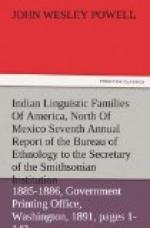The difficulties inherent in the study of languages, together with the imperfect material and the complicating conditions that have arisen by the spread of civilization over the country, combine to make the problem one not readily solved.
In view of the amount of material on hand, the comparative study of the languages of North America has been strangely neglected, though perhaps this is explained by reason of the difficulties which have been pointed out. And the attempts which have been made to classify them has given rise to much confusion, for the following reasons: First, later authors have not properly recognized the work of earlier laborers in the field. Second, the attempt has more frequently been made to establish an ethnic classification than a linguistic classification, and linguistic characteristics have been confused with biotic peculiarities, arts, habits, customs, and other human activities, so that radical differences of language have often been ignored and slight differences have heen held to be of primary value.
The attempts at a classification of these languages and a corresponding classification of races have led to the development of a complex, mixed, and inconsistent synonymy, which must first be unraveled and a selection of standard names made therefrom according to fixed principles.
It is manifest that until proper rules are recognized by scholars the establishment of a determinate nomenclature is impossible. It will therefore be well to set forth the rules that have here been adopted, together with brief reasons for the same, with the hope that they will commend themselves to the judgment of other persons engaged in researches relating to the languages of North America.
A fixed nomenclature in biology has been found not only to be advantageous, but to be a prerequisite to progress in research, as the vast multiplicity of facts, still ever accumulating, would otherwise overwhelm the scholar. In philological classification fixity of nomenclature is of corresponding importance; and while the analogies between linguistic and biotic classification are quite limited, many of the principles of nomenclature which biologists have adopted having no application in philology, still in some important particulars the requirements of all scientific classifications are alike, and though many of the nomenclatural points met with in biology will not occur in philology, some of them do occur and may be governed by the same rules.
Perhaps an ideal nomenclature in biology may some time be established, as attempts have been made to establish such a system in chemistry; and possibly such an ideal system may eventually be established in philology. Be that as it may, the time has not yet come even for its suggestion. What is now needed is a rule of some kind leading scholars to use the same terms for the same things, and it would seem to matter little in the case of linguistic stocks what the nomenclature is, provided it becomes denotive and universal.




